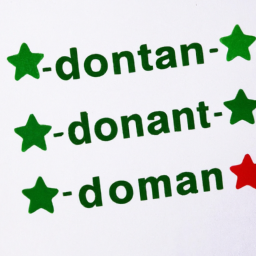7 Essential Tips for Boosting Your Domain Ratings
Table of Contents []
Domain Ratings
Introduction
Domain ratings have steadily been gaining traction over the past few years, as they provide a way to quickly and accurately measure how well a website or domain is performing on a number of external metrics. This article looks into eight to twelve different areas you should consider when rating your domain, delving deeper into popular subtopics within each of these areas to provide you with detailed insights. Each of the following topics are organised in a logical sequence so that you can gain a comprehensive understanding of what your domain is capable of and how you can best leverage it for success.
Domain Age
Domain age is often overlooked, but it is important to consider when assessing the rating of a particular domain. The age of a domain can provide insight into the quality of content offered, the amount of traffic it receives, and its overall authority in the online space. Additionally, some search engines take domain age into consideration when ranking websites, so it is important to factor this into your overall ratings if you are expecting your domain to perform well in organic search.
Content Quality
When analyzing the overall rating of your domain, the content quality is a key factor. Quality content establishes a connection with users and ensures that visitors will stay on your website longer. It also helps build authority and trust amongst your audience, creating the potential for increased conversion rates. Content should be regularly updated to ensure it is up-to-date and relevant to the topic. Quality content should also be structured in a way that is user-friendly, with titles, headings, and subheadings to make it easier to read.
Backlinks
Backlinks are essentially links from other websites pointing to your website and are an important factor for search engine rankings. When assessing the performance of your domain, it's important to take into consideration how many backlinks your website has and of what quality they are. High-quality backlinks from reputable websites can help boost your domain's ratings, whereas low-quality backlinks can do more harm than good.
User Experience and Navigation
User experience (UX) is a key factor when rating a domain, as this is what ultimately determines whether a visitor is likely to stay on a website. Simple and intuitive navigation is essential for UX as this prevents users from getting lost on the website. Additionally, design should be used to help drive the user journey and help ensure that users can find what they are looking for quickly and easily.
Visitor Engagement
Visitor engagement is also key for assessing the overall rating of a domain. Websites with high levels of visitor engagement are generally seen as more valuable, as they offer the potential for increased conversion rates. This can be measured by keeping track of the time spent on a website and the number of pages that are visited.
Optimization and Responsiveness
Optimizing a website for performance is essential for receiving a good rating. This includes both ensuring that the website is optimized for both desktop and mobile users, as well as making sure that the website loads quickly. Additionally, websites should be optimized for search engine rankings through SEO techniques such as link building and keyword research.
Branding and Identity
Your domain rating can be further improved by having a strong brand presence. This includes having a recognisable logo, distinct typography, and consistent use of colour throughout the website. Additionally, having a clear brand mission and positioning makes it easier for users to understand the values of your brand and gives them a reason to stay on the website.
Security Protocols
Security is an important factor that often gets overlooked when assessing a domain's rating. A secure website ensures that user data is kept private and helps protect visitors from malicious activities such as phishing or data breaches. SSL certificates, two-factor authentication, malware scans, and regular backups are just some of the security measures you should consider implementing if you want to boost the rating of your domain.
Social Media Presence
It is important to take into consideration the presence a website has on social media when assessing its overall rating. Relevant social media presence can help to build an audience for your website, helping to drive more traffic and potentially improving conversion rates. Additionally, if the content on your website is regularly posted to social media, this can help to boost its visibility and your website's authority overall.
Analytics and Tracking
An important part of assessing the rating of a domain is to evaluate the website's analytics and tracking. This often involves tracking the number of visitors to the website, their behaviour, and how well various parts of the website are performing. Regular tracking helps to provide insights into what works well and where improvements can be made.
Conclusion
Domain ratings are an important metric to assess the performance of a website, and these can be further improved by taking into consideration eight to twelve different areas. Factors such as the domain age, content quality, backlinking, user experience and navigation, visitor engagement, optimization and responsiveness, branding and identity, security protocols, social media presence, and analytics and tracking are all essential components when rating your domain. By looking at each of these areas in turn, you can gain a comprehensive understanding of how well your website is performing, helping you to make the necessary improvements to gain a higher rating.
